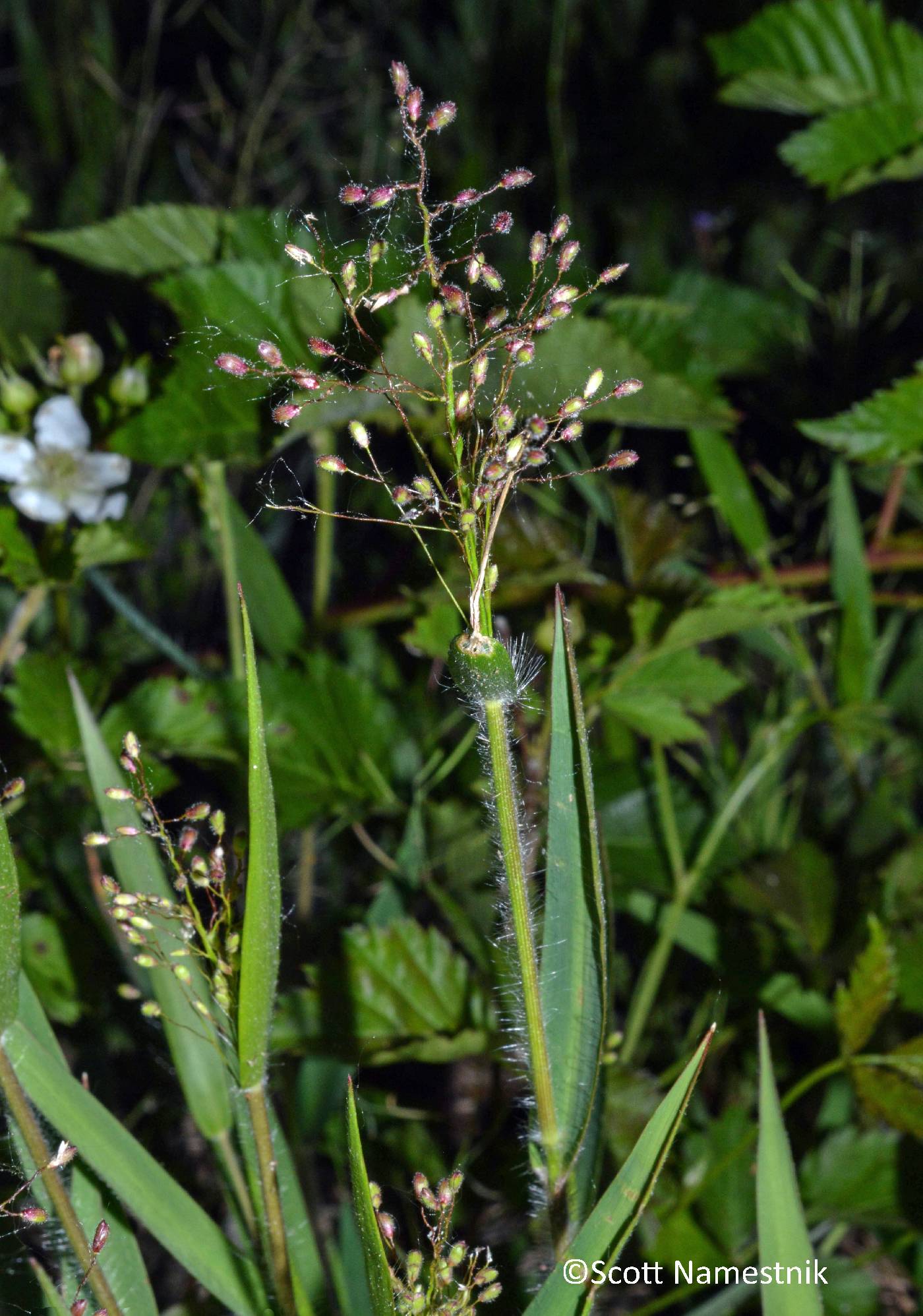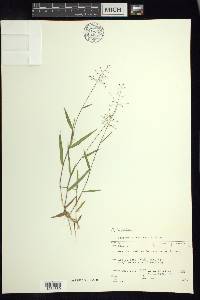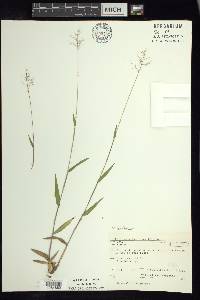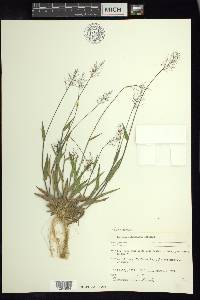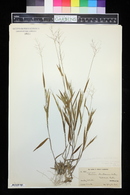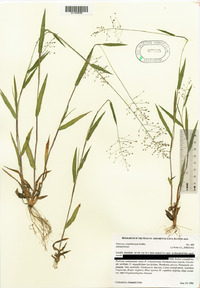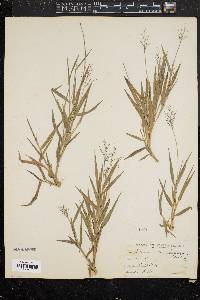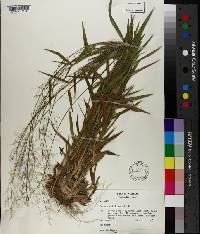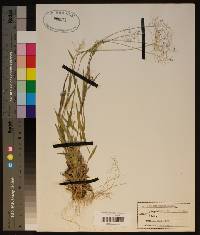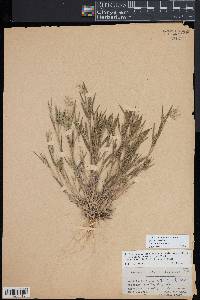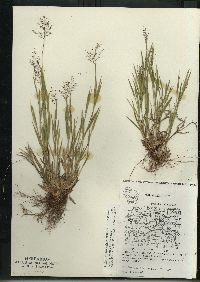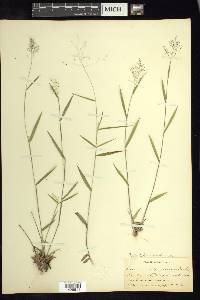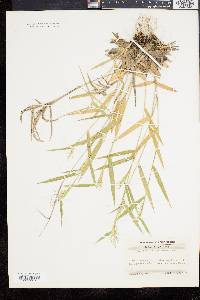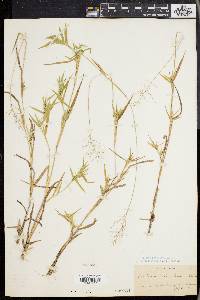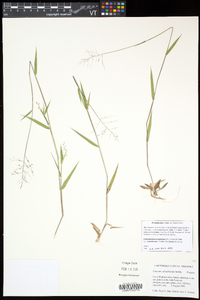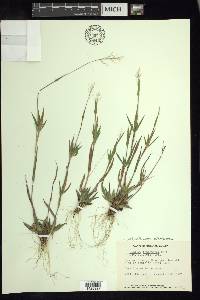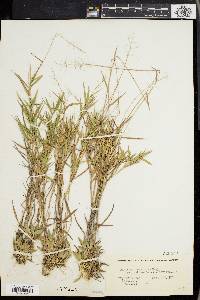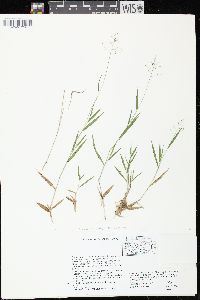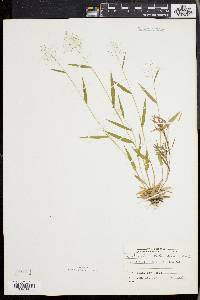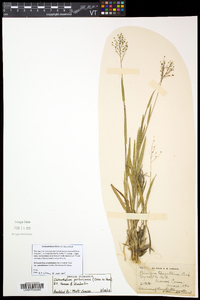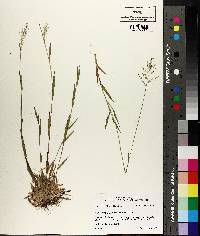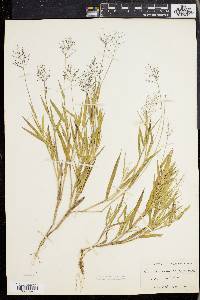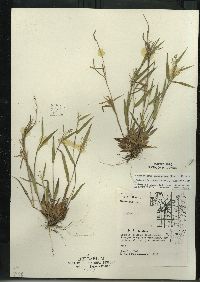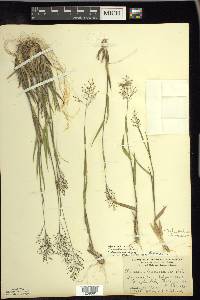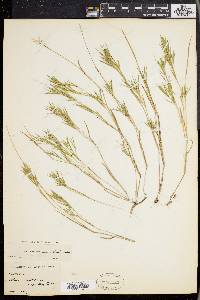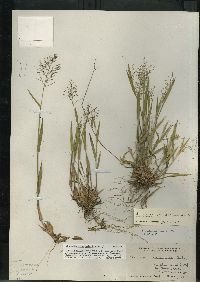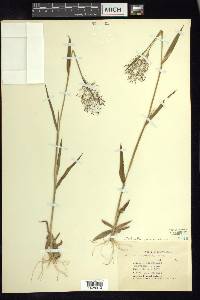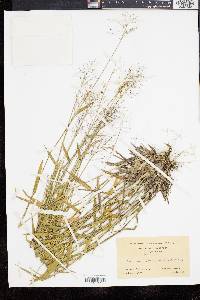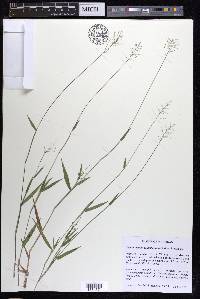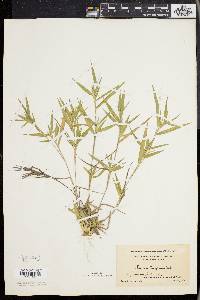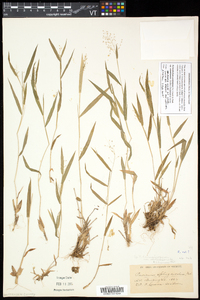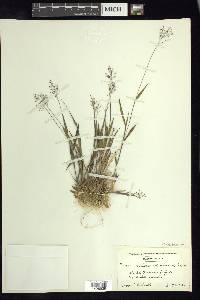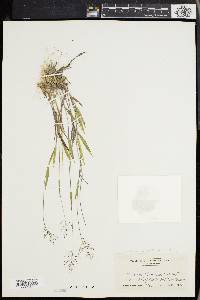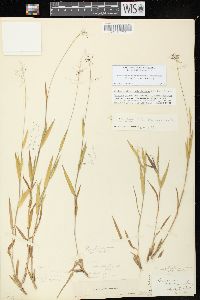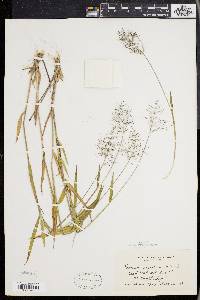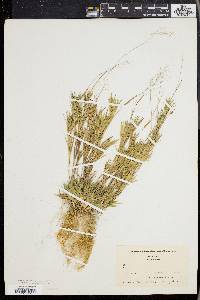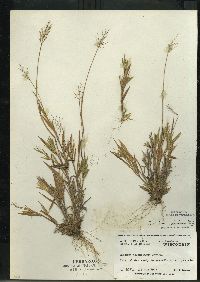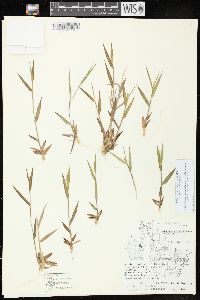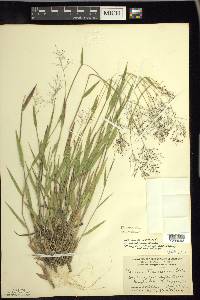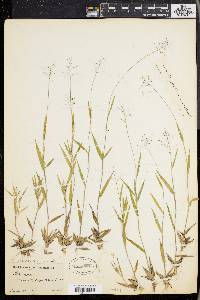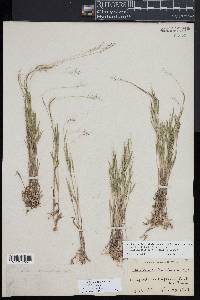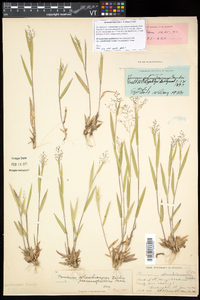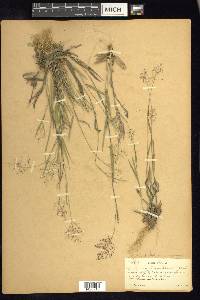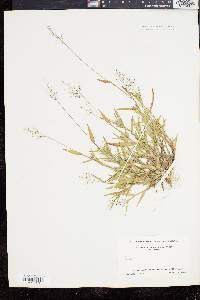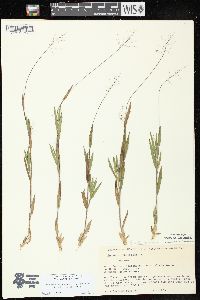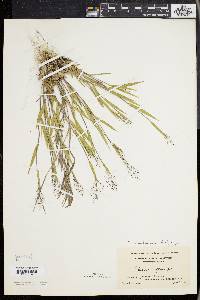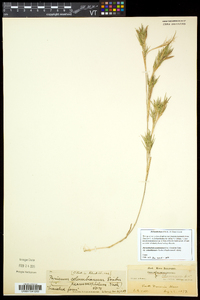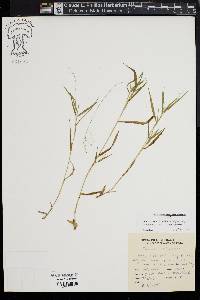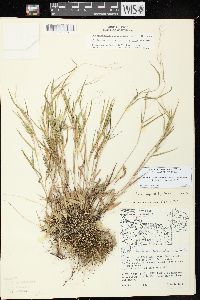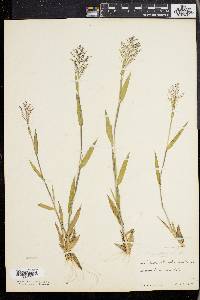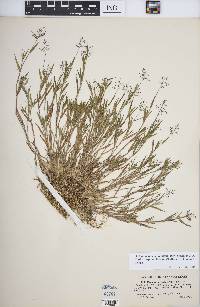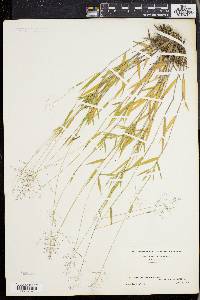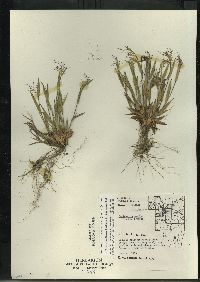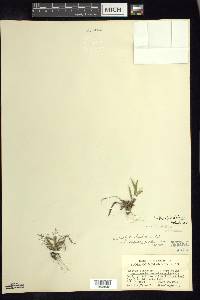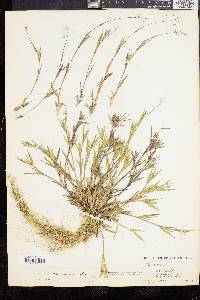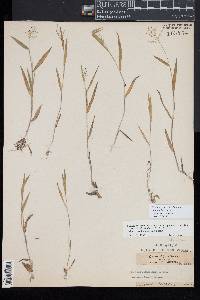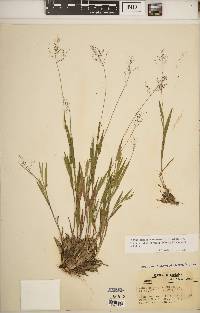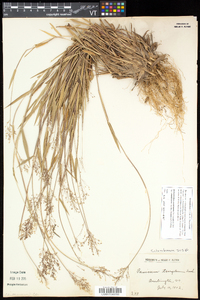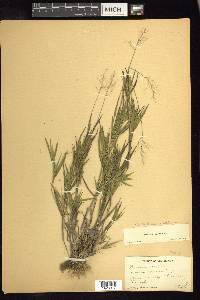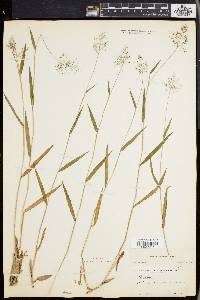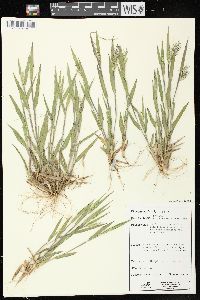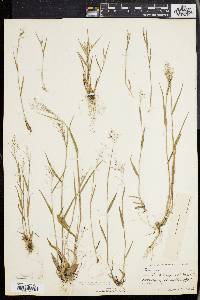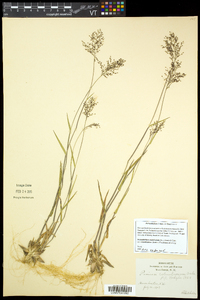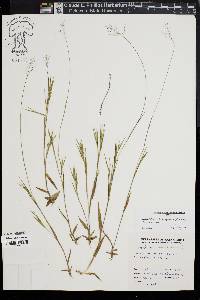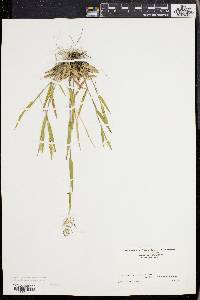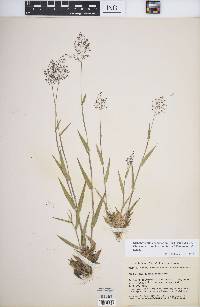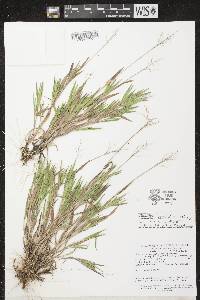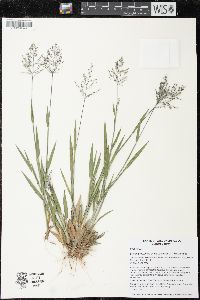Dichanthelium acuminatum subsp. columbianum
|
|
|
|
Family: Poaceae
Columbia Witch Grass, more... (fr: Panic du District de Columbia)
[Dichanthelium columbianum (Scribn.) Freckmann, moreDichanthelium sabulorum var. thinium (Hitchcock & Chase) F.W.Gould & C.A.Clark, Panicum acuminatum var. columbianum (Scribner) M.G.Lelong, Panicum columbianum Scribn., Panicum columbianum var. thinium (Hitchc. & Chase) Hitchc. & Chase, Panicum heterophyllum var. thinium (Hitchc. & Chase) Hubbard, Panicum sabulorum var. thinium (Hitchc. & Chase) C.F.Reed, Panicum unciphyllum var. thinium Hitchc. & Chase] |
Plants cespitose, pale bluish- or grayish-green. Culms erect to ascending, densely puberulent, longer hairs often present also, at least on the lower portion of the culms; nodes puberulent; fall phase with spreading or decumbent culms, branching early from most nodes, secondary blades not as greatly reduced or as densely crowded as in subsp. acuminatum, subsp. fasciculatum, subsp. implicatum, and subsp. leucothrix. Cauline sheaths pubescent, their pubescence similar to that of the culms but somewhat less dense; midculm sheaths about 1/2 as long as the internodes; ligules 1-1.5 mm; blades 3-7 cm long, 3-7 mm wide, relatively firm, often ascending, abaxial surfaces densely puberulent to nearly glabrous, adaxial surfaces glabrous or sparsely pilose near the base, margins whitish-scabridulous. Spikelets 1.5-1.9 mm, broadly ellipsoid or obovoid, puberulent. Dichanthelium acuminatum subsp. columbianum grows in sandy woods or clearings. It is much less common than the other eastern subspecies of D. acuminatum. Occasionally, it resembles the more widespread subsp. fasciculatum, subsp. implicatum, and subsp. lindheimeri. The culms and sheaths of Dichanthelium acuminatum subsp. columbianum are always puberulent with very short hairs. This puberulence should not be confused with the slightly longer hairs that develop on the secondary branches of other taxa. Perennial herb, tufted 15 cm - 1 m tall Inflorescence: a terminal, branched arrangement of spikelets (panicle). Primary panicles atop the culms, often open, rather dense, 3 - 12 cm long, one-fourth to three-fourths as wide as long, well-exserted. Secondary panicles (when present) atop the branches. Fruit: a caryopsis, indehiscent, enclosed within the persistent lemma and palea. Culm: upright to ascending, 15 cm - 1 m long, round in cross-section, hollow, minutely hairy. Nodes sometimes swollen, minutely hairy. Fall phase decumbent or spreading, branching from most of the nodes. Spikelets: 1.5 - 2 mm long, broadly ellipsoid or reverse egg-shaped with a blunt to nearly pointed apex, minutely hairy. Basal leaves: in a rosette. Blades shortly egg-shaped to lance-shaped, distinct from stem blades. Stem leaves: four to seven, alternate, two-ranked. Sheaths usually shorter than internodes (about half as long at mid-culm), hairy (hairs under 3 mm long). Ligules 1 - 1.5 mm long, composed of hairs. Blades more or less firm, frequently ascending, distinctly longer and narrower than basal leaves, 3 - 7 cm long, 3 - 7 mm wide, lance-shaped with a rounded or almost heart-shaped base, parallel-veined, nearly hairless to densely hairy beneath, sometimes sparsely soft-hairy near the base above, marginally whitish and minutely rough. Glumes:: Lower glumes usually one-fourth to one-half as long as spikelets, blunt to pointed at the apex. Upper glumes rounded to pointed at the apex. Lemmas:: Lower lemmas similar to upper glumes. Upper lemmas longitudinally lined, shiny, with rolled-up margins above. Paleas:: Lower paleas shorter than lower lemmas, thin. Upper paleas longitudinally lined. Florets:: Lower florets sterile. Upper florets bisexual, stalkless, 1 - 1.5 mm long, 0.5 - 1 mm wide, ellipsoid with a blunt to pointed apex, plump. Anthers three. Stigmas red. Similar species: No information at this time. Flowering: June to mid-September Habitat and ecology: Frequent in the eastern counties of the Chicago Region in dry, sandy soil. Occurence in the Chicago region: native Etymology: Dichanthelium comes from the Greek words di, meaning twice, and anth, meaning flowering, referring to plants that may have two flowering periods. Acuminatum means "tapering to a long point." Columbianum means "of the District of Columbia." Author: The Morton Arboretum Culms clustered, erect or ascending, often purplish, densely short-pubescent with minute hairs 0.1-0.4 mm, and generally with some intermingled longer hairs (often 1 mm) toward the summit of the lower internodes; sheaths likewise with bistratal pubescence; ligule a band of hairs 0.5-1.5 mm; blades 1-7 cm נ3-7 mm (those of the midstem commonly 2-5 cm), glabrous above or with a few widely scattered hairs, minutely puberulent beneath; primary panicle ovoid, mostly 2.5-4 cm, its axis puberulent; spikelets finely hairy, oblong-ovoid, obtuse, 1.3-1.9 mm, the first glume triangular-ovate, two-fifths as long; autumnal phase spreading or decumbent, branched early from most of the nodes, the blades scarcely reduced, the panicles smaller, surpassed by the lvs; 2n=18. Moist or dry, especially sandy soil; Me. to Minn., s. to Va., Tenn., and Ill. (P. oricola; P. tsugetorum; Dichanthelium c.; D. sabulorum var. thinium) Perhaps properly to be subordinated to P. acuminatum Sw. Gleason, Henry A. & Cronquist, Arthur J. 1991. Manual of vascular plants of northeastern United States and adjacent Canada. lxxv + 910 pp. ©The New York Botanical Garden. All rights reserved. Used by permission. From Flora of Indiana (1940) by Charles C. Deam My only specimens [of Panicum columbianum] are from the H. H. Peele woods about a mile and a half southwest of Knox, Starke County. They were found in dry, sandy soil in a flat, black and white oak woods where they were closely associated with Panicum Deamii. In 1938 I found it in Steuben County. [Deam recognizes Panicum tsugetorum, which in modern treatments belongs to Dichanthelium acuminatum subsp. columbianum. It has slightly longer spikelets. He says:] this is another Panicum which is restricted to the northern part of the state and is found in dry, sandy or gravelly soils on wooded slopes and dunes. It is included by some authors with Panicum columbianum Scribn. ...... These plants are treated as a distinct species, D. columbianum, by J. Thomas (2015). Populations are distributed across the northern-most tier of counties plus Starke County. Indiana Coefficient of Conservatism: C = 8 Wetland Indicator Status: FAC |

